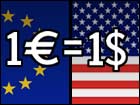
NEW YORK (CNN/Money) - The dollar slipped below parity with the euro Monday for the first time in two-and-a-half years, reflecting worries about the U.S. economy and stocks.
The breakthrough lent a psychological boost to the euro's supporters, but economists said it was less a sign of new strength in Europe's economies than a milestone in the decline of the dollar.
Huge U.S. trade deficits and the accounting scandals rocking Wall Street have had experts predicting the dollar's fall and the euro's eventual rise above $1 for weeks.
Despite the beating suffered by U.S. equities, U.S. Treasurys also retreated Monday, as worries about corporate malfeasance and the dollar's weakness spread beyond the stock markets.
The euro, which has gained about 15 percent in value since starting its rally in early April, hit parity at around midday Monday and later touched $1.0087 before easing. In late trading in New York, the euro was quoted at $1.0061, up from 99.08 cents at last week's close.
For Americans, a stronger euro means higher prices for imported goods from French wine to German sports cars. But it also offers relief to U.S. manufacturers by making their goods cheaper compared with those of foreign competitors.
From Europe's point of view, it helps keep inflation under control and makes it less likely the European Central Bank will raise interest rates to control prices, a move that can hurt economic growth.
The euro has rallied despite an absence of encouraging economic news from the 12 countries using the currency. First-quarter growth in the euro zone was an anemic 0.3 percent, though most economists predict a pickup in the second half of this year.
Instead, the euro's rise has been driven by bad news from Wall Street, where stocks have fallen for eight consecutive weeks. On Monday, the Dow Jones industrial average was down another 3.8 percent in afternoon trading in New York.
"It's still a dollar-negative story, not a euro-positive story," said Commerzbank economist Michael Schubert.
The euro's strength could also help its supporters blunt criticism that businesses -- restaurants and bars, for instance -- jacked up prices when euro cash was introduced in January. It could also improve the euro's image in Britain, Sweden and Denmark, which have declined to use the currency so far.
But the stronger euro also cuts into the price advantage held by European exporters -- often the industries that European countries, especially Germany, expect to lead their economies out of the doldrums.
Foreign investors kept the dollar high for years because they needed dollars to buy a piece of the U.S. stock market boom. That offset soaring trade deficits -- Americans buy more from overseas than they can sell abroad -- that tend to undermine a country's currency.

Some of the money fleeing stocks has sought safety in the euro zone, where higher interest rates make for a more attractive place to invest.
The euro hit its all-time high of $1.18 shortly after its launch on Jan. 1, 1999, but then began a long slide, falling through the $1 mark in February 2000 and hitting a record low of 82.30 cents in October 2000.
Some economists are cautious on whether the euro's rally can last.
The euro will sink again if the United States straightens out its problems with corporate accounting and investors regain their appetite for the risks of owning stocks, said Julian von Landesberger, an economist at HVB bank in Munich.
"At some point a discussion is going to kick off about whether it hasn't overreached," he said. Landesberger forecast that the euro will reach $1.05 by the end of the year, but retreat to 98 cents a year from now.
The dollar purchased ¥116.13, down from ¥116.87 at last week's close.
Bonds lose early-day stability
The bond markets were calm early Monday, but then began to give ground as the day wore on.
The two-year note gained 1/32 of a point to 100-22/32 to yield 2.50 percent, while the five-year note fell 3/32 of a point to 102-19/32, yielding 3.77 percent.
Ten-year notes shed 9/32 of a point to 102 even, yielding 4.61 percent against 4.59 percent Friday, while 30-year bonds dropped 20/32 to 100 even to yield 5.37 percent, up from 5.32 percent last week.
Treasurys, which usually trade inversely to the stock market, initially appeared to shrug off a report on May business inventories while awaiting congressional testimony on monetary policy from Federal Reserve Chairman Alan Greenspan Tuesday.
Analysts see the Fed chief striking a positive note on the economy's recovery and downplaying the odds the economy will fall back into recession, even as he acknowledges that risks remain to the recovery.
Such a suggestion of optimism from the Fed chief may be the reason why the rally in Treasurys faltered at the end of trading Monday.
"I expect Greenspan's going to say something that is going to talk about growth in the economy. Bonds will go down," Remy said. Remy said he thought the bond market's big rally was running out of room, "but I would have said that to you a week ago."

-- from staff and wire reports
|

